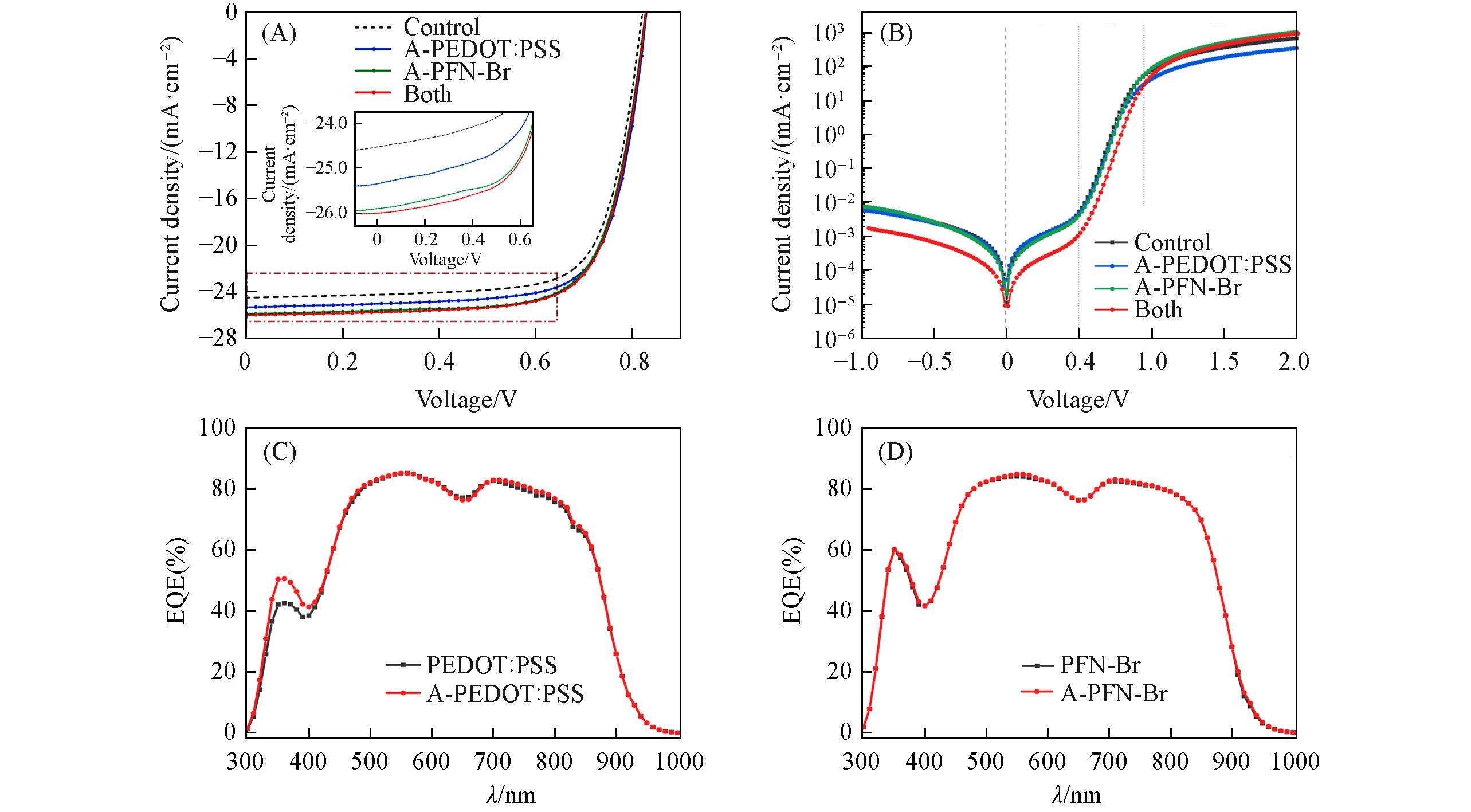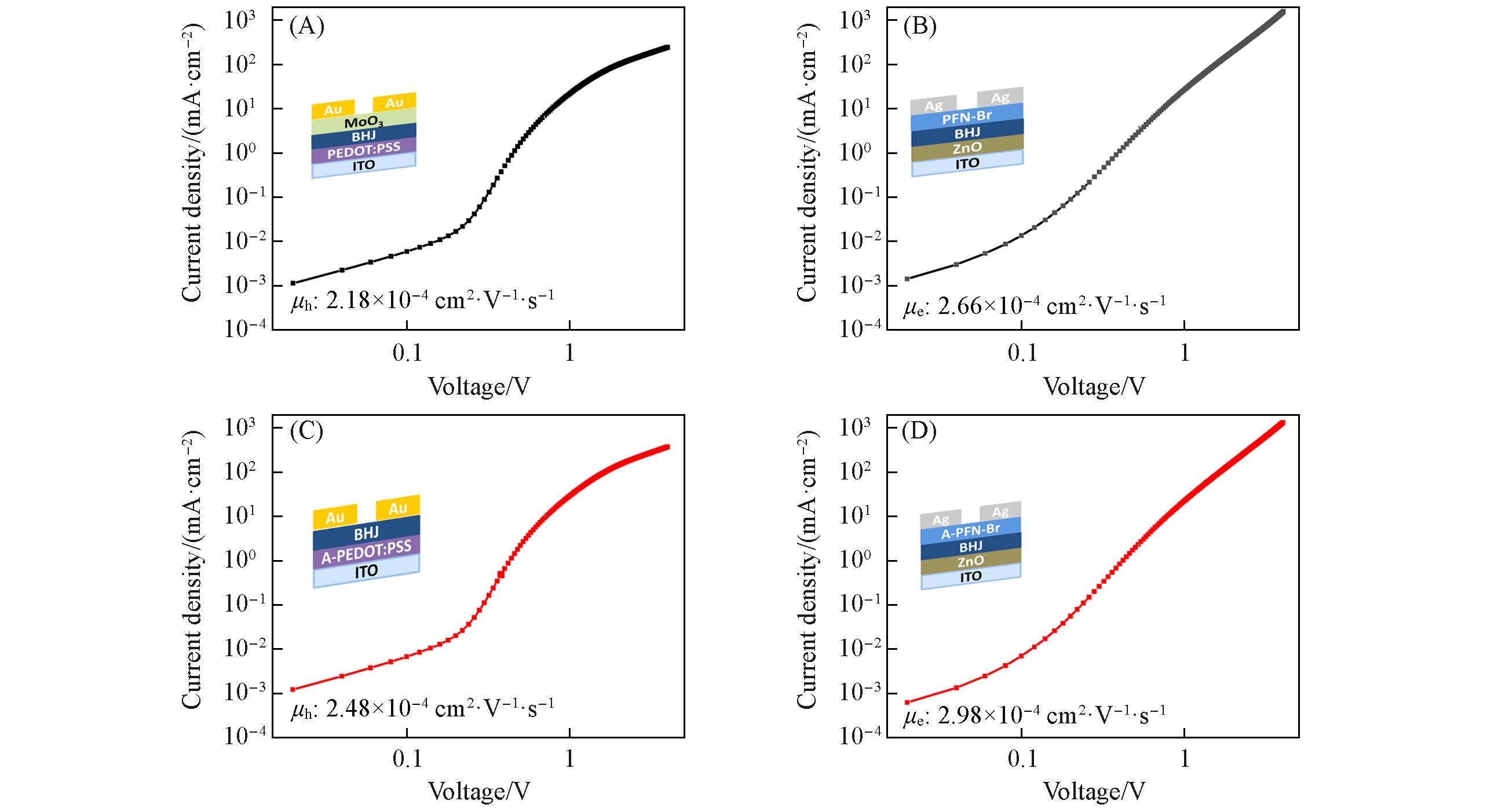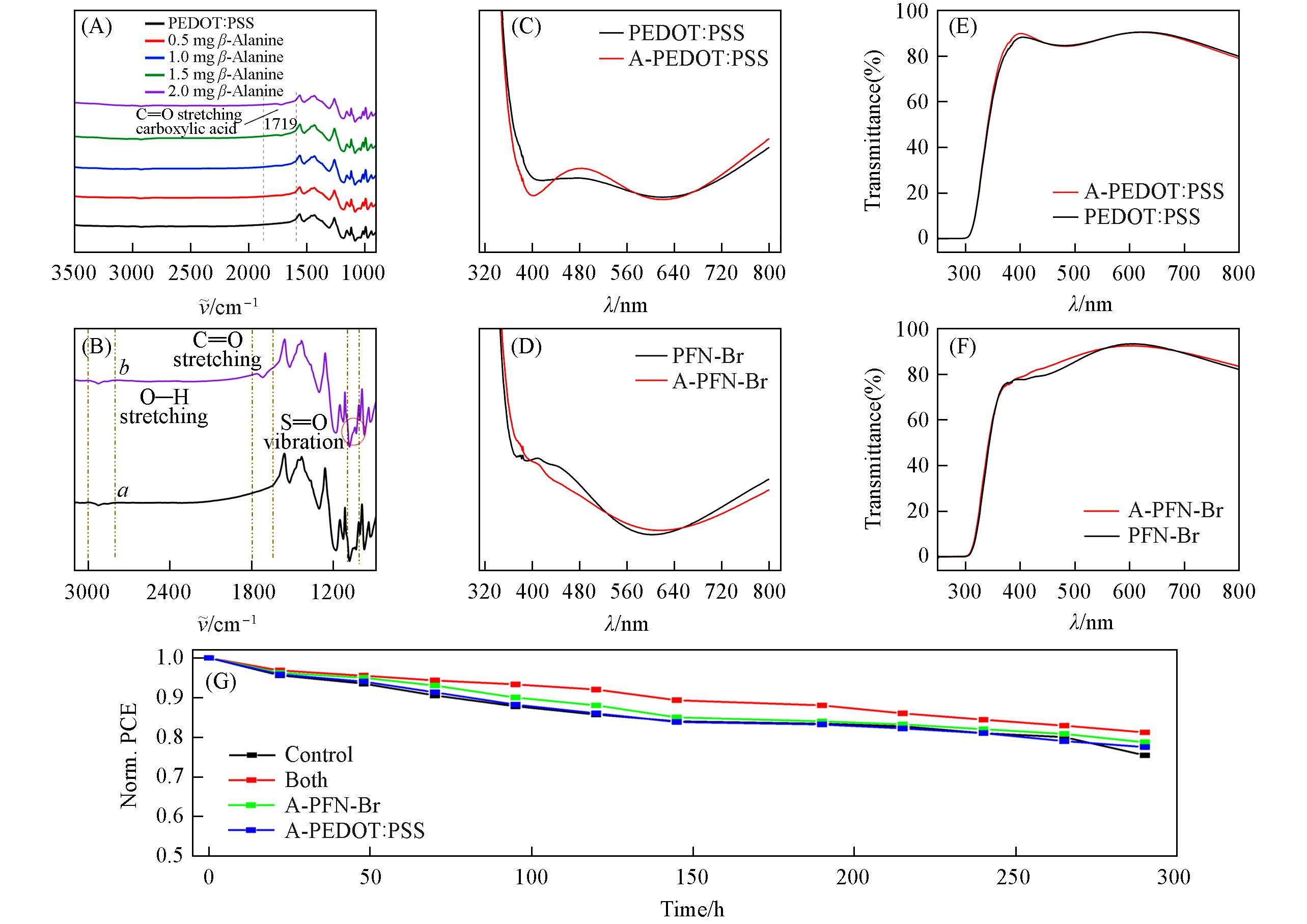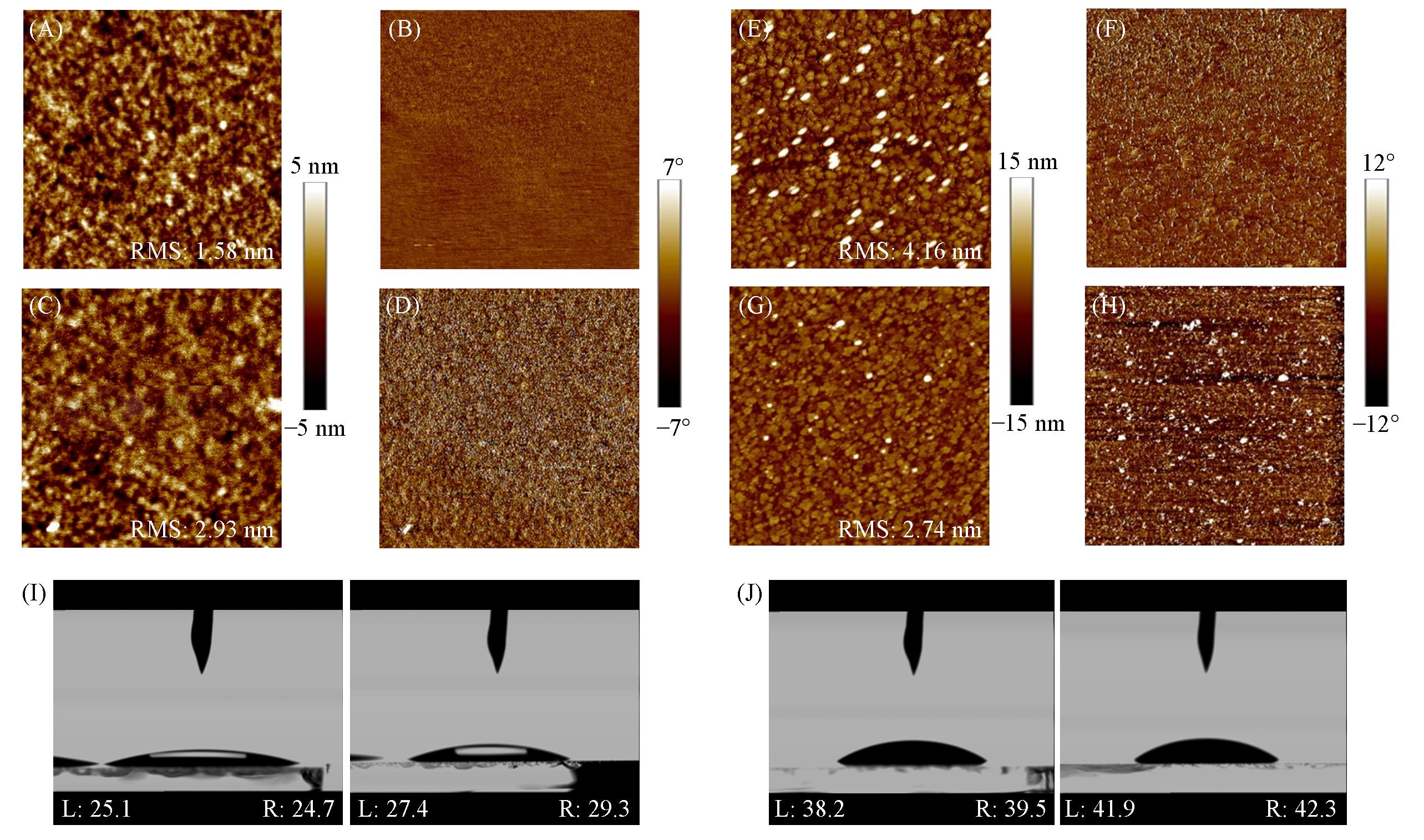

高等学校化学学报 ›› 2023, Vol. 44 ›› Issue (9): 20230185.doi: 10.7503/cjcu20230185
ZAFAR Saud uz1, 张伟超2, 杨朔3, 李世麟2, 张莹玉1, 张渊2, 张弘1( ), 周惠琼1(
), 周惠琼1( )
)
收稿日期:2023-04-12
出版日期:2023-09-10
发布日期:2023-06-01
通讯作者:
张弘,周惠琼
E-mail:zhanghong@nanoctr.cn;zhouhq@nanoctr.cn
基金资助:
ZAFAR Saud uz1, ZHANG Weichao2, YANG Shuo3, LI Shilin2, ZHANG Yingyu1, ZHANG Yuan2, ZHANG Hong1( ), ZHOU Huiqiong1(
), ZHOU Huiqiong1( )
)
Received:2023-04-12
Online:2023-09-10
Published:2023-06-01
Contact:
ZHANG Hong, ZHOU Huiqiong
E-mail:zhanghong@nanoctr.cn;zhouhq@nanoctr.cn
Supported by:摘要:
β-丙氨酸分子的两侧分别为1个羟基(—OH)/羧基(—COOH)和1个胺基(—NH2), 这使其成为一种理想的双修饰剂. 本文将双修饰技术应用于空穴传输层[HTL, 聚(3,4-乙烯二氧噻唑)∶聚(苯乙烯磺酸盐)(PEDOT∶PSS)]以及电子传输层(ETL), 并通过简单的溶液处理技术将聚(9,9-双(3'-(N,N-二甲基)-N-乙基氨丙基-2,7-芴)-2,7-(9,9-二辛基芴))二溴化物(PFN-Br)加入同一装置中, 从而合成了新界面层. 将甲醇和水作为极性溶剂, 使β-丙氨酸成为可溶解的化合物. 通过这种双重修饰方法, PM6∶Y6太阳能电池的光电转换效率(PCE)从14.99%提高到15.78%. 接触角测量和傅里叶变换红外光谱(FTIR)表征结果表明, 两层界面都得到了增强的疏水性, 从而避免了水分和氧气与它们各自的电极发生作用. 利用原子力显微镜对表面形貌进行了分析. 结果表明, β-丙氨酸的胺基与PSS的—SO
中图分类号:
TrendMD:
ZAFAR Saud uz, 张伟超, 杨朔, 李世麟, 张莹玉, 张渊, 张弘, 周惠琼. β-丙氨酸作为有机太阳能电池双重修饰添加剂的研究. 高等学校化学学报, 2023, 44(9): 20230185.
ZAFAR Saud uz, ZHANG Weichao, YANG Shuo, LI Shilin, ZHANG Yingyu, ZHANG Yuan, ZHANG Hong, ZHOU Huiqiong. Beta-alanine as a Dual Modification Additive in Organic Solar Cells. Chem. J. Chinese Universities, 2023, 44(9): 20230185.

Fig.1 Chemical structures of β⁃alanine(A), PEDOT∶PSS(B) and PFN⁃Br(C), schematic illustration of mixing both transporting layers with β⁃alanine(D), schematic device structure representation of OSCs(E)
| BHJ System PM6∶Y6 | HTL/ETL | VOC/V | JSC/(mA·cm‒2) | FF(%) | PCE b (%) |
|---|---|---|---|---|---|
| Control | PEDOT∶PSS/PFN⁃Br | 0.821 | 24.52 | 74.43 | 14.99 |
| A⁃PEDOT∶PSS | With PFN⁃Br | 0.829 | 25.35 | 73.96 | 15.56 |
| A⁃PFN⁃Br | With PEDOT∶PSS | 0.827 | 25.91 | 73.39 | 15.65 |
| Both | A⁃PEDOT∶PSS/A⁃PFN⁃Br | 0.828 | 26.00 | 73.67 | 15.78 |
Table 1 Photovoltaic parameters of the conventional architecture of OSCs based on PM6∶Y6 system with pristine PEDOT∶PSS, PFN∶Br and modified versions with β ⁃alanine(A⁃PEDOT∶PSS and A⁃PFN⁃Br) a
| BHJ System PM6∶Y6 | HTL/ETL | VOC/V | JSC/(mA·cm‒2) | FF(%) | PCE b (%) |
|---|---|---|---|---|---|
| Control | PEDOT∶PSS/PFN⁃Br | 0.821 | 24.52 | 74.43 | 14.99 |
| A⁃PEDOT∶PSS | With PFN⁃Br | 0.829 | 25.35 | 73.96 | 15.56 |
| A⁃PFN⁃Br | With PEDOT∶PSS | 0.827 | 25.91 | 73.39 | 15.65 |
| Both | A⁃PEDOT∶PSS/A⁃PFN⁃Br | 0.828 | 26.00 | 73.67 | 15.78 |

Fig.2 Current density versus voltage(J⁃V) curves of PM6∶Y6 active layer using different ETL and HTL modified layers(control, A⁃PEDOT∶PSS, A⁃PFN⁃Br and both)(A), dark J⁃V characteristics of various devices(B) and EQE spectra for PEDOT∶PSS and A⁃PEDOT∶PSS(C) and for PFN⁃Br and A⁃PFN⁃Br(D)(A) The inset picture is a zoom-in on the curves.

Fig.3 SCLC carrier mobility graphs for hole transporting layers PEDOT∶PSS(A), electron transporting layer PFN⁃Br(B), modified HTL(A⁃PEDOT∶PSS)(C) and modified ETL(A⁃PFN⁃Br)(D)Insets are device architecture structures.

Fig.4 FTIR analysis of PEDOT∶PSS with different percentages of β⁃alanine(A), FTIR of pristine PEDOT∶PSS(a) and PEDOT∶PSS with 2.0 mg of β⁃alanine(b)(B), UV⁃Vis absorption of PEDOT∶PSS and A⁃PEDOT∶PSS(C), UV⁃Vis absorption of PFN⁃Br and A⁃PFN⁃Br(D), transmittance of PEDOT∶PSS and A⁃PEDOT∶PSS(E) and transmittance of PFN⁃Br and A⁃PFN⁃Br(F), the normalized stability graph of different devices(G)

Fig.5 AFM images of PEDOT∶PSS height(A), phase(B) and A⁃PEDOT∶PSS height(C) and phase(D), PFN⁃Br height(E), phase(F), A⁃PFN⁃Br height(G), phase(H), the contact angle(water) of PEDOT∶PSS, A⁃PEDOT∶PSS(I) and PFN⁃Br and A⁃PFN⁃Br(J)
| 1 | Zhou Z., Xu S., Song J., Jin Y., Yue Q., Qian Y., Liu F., Zhang F., Zhu X., Nat. Energy, 2018, 3(11), 952—959 |
| 2 | Gao W., Qi F., Peng Z., Lin F. R., Jiang K., Zhong C., Kaminsky W., Guan Z., Lee C. S., Marks T. J., Ade H., Jen A. K. Y., Adv. Mater., 2022, 34(32), 2202089 |
| 3 | Armin A., Li W., Sandberg O. J., Xiao Z., Ding L., Nelson J., Neher D., Vandewal K., Shoaee S., Wang T., Ade H., Heumüller T., Brabec C., Meredith P., Adv. Energy Mater., 2021, 11, 2003570 |
| 4 | Duan C., Huang F., Cao Y., Polym. Chem., 2015, 6(47), 8081—8098 |
| 5 | Wang J., Zheng Z., Zhang D., Zhang J., Zhou J., Liu J., Xie S., Zhao Y., Zhang Y., Wei Z., Hou J., Tang Z., Zhou H., Adv. Mater., 2019, 31(17), 1806921 |
| 6 | Du X., Heumueller T., Gruber W., Almora O., Classen A., Qu J., He F., Unruh T., Li N., Brabec C. J., Adv. Mater.,2020, 32(16), e1908305 |
| 7 | Che X., Li Y., Qu Y., Forrest S. R., Nat. Energy, 2018, 3(5), 422—427 |
| 8 | Yin Z., Wei J., Zheng Q., Adv. Sci., 2016, 3(8), 1500362 |
| 9 | Li Y., Ding J., Liang C., Zhang X., Zhang J., Jakob D. S., Wang B., Li X., Zhang H., Li L., Yang Y., Zhang G., Zhang X., Du W., Liu X., Zhang Y., Zhang Y., Xu X., Qiu X., Zhou H., Joule, 2021, 5(12), 3154—3168 |
| 10 | Chen M., Wang J., Yin F., Du Z., Belfiore L. A., Tang J., J. Mater. Chem. A, 2021, 9(8), 4505—4527 |
| 11 | Kalkan S. B., Najafidehaghani E., Gan Z., Apfelbeck F. A. C., Hübner U., George A., Turchanin A., Nickel B., npj 2D Mater. Appl., 2021, 5(1), 92 |
| 12 | Kang H., Hong S., Lee J., Lee K., Adv. Mater., 2012, 24(22), 3005—3009 |
| 13 | Liu M., Xu Y., Gao Z., Zhang C., Yu J., Wang J., Ma X., Hu H., Yin H., Zhang F., Man B., Sun Q., Nanoscale, 2021, 13(25), 11128—11137 |
| 14 | Wu J., Gao M., Chai Y., Liu P., Zhang B., Liu J., Ye L., Mater. Reports: Energy, 2021, 1(4), 100062 |
| 15 | Kim H. I., Bui T. T. T., Kim G. W., Kang G., Shin W. S., Park T., ACS App. Mater. Interfaces, 2014, 6(18), 15875—15880 |
| 16 | Zhang X., Zhang H., Li Y., Zafar S. U., Yang S., Chen J., Zhou H., Zhang Y., Adv. Funct. Mater., 2022, 32(44), 2205398 |
| 17 | Pei S., Xiong X., Zhong W., Xue X., Zhang M., Hao T., Zhang Y., Liu F., Zhu L., ACS App. Mater. Interfaces, 2022, 14(30), 34814—34821 |
| 18 | Zheng Z., Hu Q., Zhang S., Zhang D., Wang J., Xie S., Wang R., Qin Y., Li W., Hong L., Liang N., Liu F., Zhang Y., Wei Z., Tang Z., Russell T. P., Hou J., Zhou H., Adv. Mater., 2018, 30(34), 1801801 |
| 19 | Mengistie D. A., Chen C. H., Boopathi K. M., Pranoto F. W., Li L. J., Chu C. W., ACS App. Mater. Interfaces, 2015, 71, 94—100 |
| 20 | Zhang L., Yang K., Chen R., Zhou Y., Chen S., Zheng Y., Li M., Xu C., Tang X., Zang Z., Sun K., Adv. Electr. Mater., 2020, 6(1), 1900648 |
| 21 | Tang H., Liu Z., Hu Z., Liang Y., Huang F., Cao Y., Sci. China Chem., 2020, 63(6), 802—809 |
| 22 | Cassinelli M., Park W. T., Kim Y., Kim J. H., Noh Y. Y., Caironi M., App. Phys. Lett., 2021, 119(3), 033301 |
| 23 | Hu L., Song J., Yin X., Su Z., Li Z., Polymers, 2020, 12(1), 145 |
| 24 | Li B., Xiang Y., Jayawardena K. D. G. I., Luo D., Wang Z., Yang X., Watts J. F., Hinder S., Sajjad M. T., Webb T., Luo H., Marko I., Li H., Thomson S. A. J., Zhu R., Shao G., Sweeney S. J., Silva S. R. P., Zhang W., Nano Energy, 2020, 78, 105249 |
| 25 | Chen S., Song L., Tao Z., Shao X., Huang Y., Cui Q., Guo X., Org. Electr., 2014, 15(12), 3654—3659 |
| 26 | Liu D., Xu H., Liu X., Xie Z., Yang B., Ma Y., Chem. Phys. Lett., 2011, 514(1), 174—180 |
| 27 | Cameron J., Skabara P. J., Mater. Horizons, 2020, 7(7), 1759—1772 |
| 28 | Ionescu⁃Zanetti C., Mechler A., Carter S. A., Lal R., Adv. Mater., 2004, 16(7), 579 |
| 29 | Liao Q., Kang Q., Yang Y., An C., Xu B., Hou J., Adv. Mater., 2020, 32(7), 1906557 |
| 30 | Liu Y., Cole M. D., Jiang Y., Kim P. Y., Nordlund D., Emrick T., Russell T. P., Adv. Mater., 2018, 30(15), 1705976 |
| 31 | Li Y., Sci. China Chem., 2016, 59(11), 1430—1431 |
| 32 | Jia J., Fan B., Xiao M., Jia T., Jin Y., Li Y., Huang F., Cao Y., Macromolecules, 2018, 51(6), 2195—2202 |
| 33 | Hu Z., Chen Z., Zhang K., Zheng N., Xie R., Liu X., Yang X., Huang F., Cao Y., Solar RRL, 2017, 1(6), 1700055 |
| 34 | Guan L., Yu L., Wu L., Zhang S., Lin Y., Jiao Y., Zhang S., Zhao F., Ren Y., Zhou X., Liu Z., Thin Solid Films, 2021, 732, 138770 |
| 35 | Ming Y., Zhu Y., Chen Y., Jin B., Duan C., Liang Z., Zhao L., Wang S., Dong B., Li H., Wu C., ACS App. Mater. Interfaces, 2021, 13(48), 57163—57170 |
| 36 | Yuan H., Zhang Z., Guo T., Yu L., Deng Z., Zhao R., Zhang J., Zhu Y., J. Alloys Comp., 2021, 876, 160140 |
| 37 | Zheng Z., Zhang S., Zhang J., Qin Y., Li W., Yu R., Wei Z., Hou J., Adv. Mater., 2016, 28(25), 5133—5138 |
| 38 | Sun P., Liu Y., Du S., Yu B., Wang Y., Sun M., Shi P., Liu Y., Gong J., J. Mol. Liquids, 2017, 232, 522—531 |
| 39 | Zou F., Zhuang W., Wu J., Zhou J., Liu Q., Chen Y., Xie J., Zhu C., Guo T., Ying H., J. Chem. Therm., 2014, 77, 14—22 |
| 40 | Servaites J. D., Ratner M. A., Marks T. J., Ener. Env. Sci., 2011, 4(11), 4410—4422 |
| 41 | Servaites J. D., Yeganeh S., Marks T. J., Ratner M. A., Adv. Funct. Mater., 2010, 20(1), 97—104 |
| 42 | Wu N., Luo Q., Bao Z., Lin J., Li Y. Q., Ma C. Q., Sol. Energy Mater. Sol. Cells, 2015, 141, 248—259 |
| 43 | Wolf U., Arkhipov V. I., Bässler H., Phy. Review B, 1999, 59(11), 7507—7513 |
| 44 | Waldauf C., Scharber M. C., Schilinsky P., Hauch J. D., Brabec C. J., J. App. Phy., 2006, 99, 104503 |
| 45 | Zhou H., Zhang Y., Seifter J., Collins S. D., Luo C., Bazan G. C., Nguyen T. Q., Heeger A. J., Adv. Mater.,2013, 25(11), 1646—1652 |
| 46 | Lee B. R., Lee S., Park J. H., Jung E. D., Yu J. C., Nam Y. S., Heo J., Kim J. Y., Kim B. S., Song M. H., Adv. Mater., 2015, 27(23), 3553—3559 |
| 47 | Konwar L. J., Mäki⁃Arvela P., Mikkola J. P., Chem. Rev., 2019, 119(22), 11576—11630 |
| 48 | Hara M., Yoshida T., Takagaki A., Takata T., Kondo J. N., Hayashi S., Domen K., Angew. Chem. Int. Ed., 2004, 43(22), 2955—2958 |
| 49 | Li H., Zhang C., Ma Y., Mai Y., Xu Y., Org. Electr., 2018, 62, 468—473 |
| 50 | Aleshin A. N., Williams S. R., Heeger A. J., Syn. Metals., 1998, 94(2), 173—177 |
| 51 | Greczynski G., Kugler T., Salaneck W. R., Thin Solid Films, 1999, 354(1), 129—135 |
| 52 | Kemerink M., Timpanaro S., de Kok M. M., Meulenkamp E. A., Touwslager F. J., J. Phy. Chem. B, 2004, 108(49), 18820—18825 |
| 53 | Galatopoulos F., Papadas I. T., Ioakeimidis A., Eleftheriou P., Choulis S. A., Nanomaterials, 2020, 10(10), 1961 |
| 54 | Müller C., Hamedi M., Karlsson R., Jansson R., Marcilla R., Hedhammar M., Inganäs O., Adv. Mater., 2011, 23(7), 898—901 |
| 55 | Liao C., Zhang M., Yao M. Y., Hua T., Li L., Yan F., Adv. Mater., 2015, 27(46), 7493—7527 |
| 56 | Crispin X., Jakobsson F. L. E., Crispin A., Grim P. C. M., Andersson P., Volodin A., van Haesendonck C., Van der Auweraer M., Salaneck W. R., Berggren M., Chem. Mater., 2006, 18(18), 4354—4360 |
| 57 | Xu H., Yuan F., Zhou D., Liao X., Chen L., Chen Y., J. Mater. Chem. A, 2020, 8(23), 11478—11492 |
| 58 | Li W., Zhang W., Van Reenen S., Sutton R. J., Fan J., Haghighirad A. A., Johnston M. B., Wang L., Snaith H. J., Ener. Env. Sci., 2016, 9(2), 490—498 |
| 59 | Dag I., Lifshitz E., J. Phy. Chem., 1996, 100(21), 8962—8972 |
| 60 | Chang S. H., Chiang C. H., Kao F. S., Tien C. L., Wu C. G., IEEE Photo. J., 2014, 6(4), 1—7 |
| 61 | Hwang J., Schwendeman I., Ihas B. C., Clark R. J., Cornick M., Nikolou M., Argun A., Reynolds J. R., Tanner D. B., Phys. Review B, 2011, 83(19), 195121 |
| 62 | Akkerman H. B., Naber R. C. G., Jongbloed B., van Hal P. A., Blom P. W. M., de Leeuw D. M., de Boer B., Proceed. Nat. Acad. Sci., 2007, 104(27), 11161—11166 |
| 63 | Yun D. J., Jung J., Sung Y. M., Ra H., Kim J. M., Chung J., Kim S. Y., Kim Y. S., Heo S., Kim K. H., Jeong Y. J., Jang J., Adv. Elect. Mater., 2020, 6(11), 2000620 |
| 64 | Wang Q., Chueh C. C., Eslamian M., Jen A. K. Y., ACS App. Mater. Interfaces, 2016, 8(46), 32068—32076 |
| 65 | Hosseini E., Ozhukil Kollath V., Karan K., J. Mater. Chem. C, 2020, 8(12), 3982—3990 |
| 66 | Vorobyev A. Y., Guo C., Opt. Express, 2011, 19(Suppl 5), A1031 |
| 67 | Chao Y. C., Chen C. Y., Lin C. A., Dai Y. A., He J. H., J. Mater. Chem., 2010, 20(37), 8134—8138 |
| 68 | Li J., Wang N., Wang Y., Liang Z., Peng Y., Yang C., Bao X., Xia Y., Sol. Energy, 2020, 196, 168—176 |
| 69 | Shi Z., Liu H., Li J., Wang F., Bai Y., Bian X., Zhang B., Alsaedi A., Hayat T., Tan Z. A., Sol. Energy Mater. Sol. Cells, 2018, 180, 1—9 |
| 70 | Bi S., Leng X., Li Y., Zheng Z., Zhang X., Zhang Y., Zhou H., Adv. Mater., 2019, 31(45), 1805708 |
| 71 | Li Y., Zhang Z., Han X., Li T., Lin Y., CCS Chem., 2022, 4(3), 1087—1097 |
| 72 | Cha H., Wu J., Wadsworth A., Nagitta J., Limbu S., Pont S., Li Z., Searle J., Wyatt M. F., Baran D., Kim J. S., McCulloch I., Durrant J. R., Adv. Mater., 2017, 29(33), 1701156 |
| 73 | Lee S. J., Pil Kim H., Mohd Yusoff A. R. B., Jang J., Sol. Energy Mater. Sol. Cells, 2014, 120, 238—243 |
| 74 | Hermenau M., Riede M., Leo K., Gevorgyan S. A., Krebs F. C., Norrman K., Sol. Energy Mater. Sol. Cells, 2011, 95(5), 1268—1277 |
| 75 | Wang J., Yu H., Hou C., Zhang J., ACS App. Mater. Interfaces, 2020, 12(23), 26543—26554 |
| 76 | Mateker W. R., McGehee M. D., Adv. Mater., 2017, 29(10), 1603940 |
| 77 | Lin X., Wang Y., Wu J., Tang Z., Lin W., Nian L., Yi G., ACS App. Energy Mater., 2021, 4(6), 5905—5912 |
| 78 | Cho A., Kim S., Kim S., Cho W., Park C., Kim F. S., Kim J. H., J. Poly. Sci. B: PP., 2016, 54(15), 1530—1536 |
| 79 | Lee T. W., Chung Y., Adv. Funct. Mater., 2008, 18(15), 2246—2252 |
| 80 | Zhou Y., Fuentes⁃Hernandez C., Shim J., Meyer J., Giordano A. J., Li H., Winget P., Papadopoulos T., Cheun H., Kim J., Fenoll M., Dindar A., Haske W., Najafabadi E., Khan T. M., Sojoudi H., Barlow S., Graham S., Brédas J. L., Marder S. R., Kahn A., Kippelen B., Science, 2012, 336(6079), 327—332 |
| 81 | Mihailetchi V. D., Blom P. W. M., Hummelen J. C., Rispens M. T., J. App. Phys., 2003, 94(10), 6849—6854 |
| 82 | López Valdivieso A., Sánchez López A. A., Song S., Int. J. Miner. Process, 2005, 77(3), 154—164 |
| 83 | Paredes Á., Acuña S. M., Toledo P. G., Metals, 2019, 9(11), 1177 |
| 84 | Ouellette R. J., Rawn J. D., Organic Chemistry: Structure, Mechanism and Synthesis, Elsevier, Boston, 2015, 169—182 |
| 85 | Penczek S., Kubisa P., Allen G., Bevington J. C., Cationic Ring⁃opening Polymerization, Pergamon, Amsterdam, 1989, 751—786 |
| 86 | Savin K. A., Writing Reaction Mechanisms in Organic Chemistry, Academic Press, Boston, 2014, 1—53 |
| 87 | Li J., Huang X., Yuan J., Lu K., Yue W., Ma W., Org. Electr., 2013, 14(9), 2164—2171 |
| 88 | Hau S. K., Yip H. L., Acton O., Baek N. S., Ma H., Jen A. K. Y., J. Mater. Chem., 2008, 18(42), 5113—5119 |
| 89 | Chao L., Niu T., Gu H., Yang Y., Wei Q., Xia Y., Hui W., Zuo S., Zhu Z., Pei C., Zhang J., Fang J., Xing G., Li H., Huang X., Gao X., Ran C., Song L., Fu L., Chen Y., Huang W., Research, 2020, 2020, 2616345 |
| 90 | Yip H. L., Hau S. K., Baek N. S., Ma H., Jen A. K. Y., Adv. Mater., 2008, 20(12), 2376—2382 |
| [1] | 杨航, 凡晨岭, 崔乃哲, 李肖肖, 张雯婧, 崔超华. 添加剂和溶剂退火协同优化制备高性能厚膜有机太阳能电池[J]. 高等学校化学学报, 2023, 44(9): 20230162. |
| [2] | 宋欣, 高申正, 许善磊, 徐浩, 周鑫杰, 朱梦冰, 郝儒林, 朱卫国. 挥发固体添加剂调控有机太阳能电池性能的研究进展[J]. 高等学校化学学报, 2023, 44(9): 20230151. |
| [3] | 吴济发, 吴汉平, 袁琳, 彭小彬. 协同富勒烯和非富勒烯受体提高卟啉全小分子三元有机太阳能电池的性能[J]. 高等学校化学学报, 2023, 44(9): 20230136. |
| [4] | 宋亚男, 游祖豪, 王旭, 刘瑶. 电活性紫罗烯有机光伏界面材料的研究进展[J]. 高等学校化学学报, 2023, 44(9): 20230167. |
| [5] | 李伟, 陈宸, 刘丹, 王涛. 非富勒烯电子受体多尺度分子聚集体[J]. 高等学校化学学报, 2023, 44(9): 20230160. |
| [6] | 马伊帆, 张雅敏, 甘胜民, 张昱琛, 费贤, 王汀, 张则琪, 巩雪柱, 张浩力. 基于宽带隙小分子给体第三组分的三元有机光伏器件[J]. 高等学校化学学报, 2023, 44(9): 20230170. |
| [7] | 张丽婷, 仇丁丁, 张建齐, 吕琨, 魏志祥. 具有热退火提升器件VOC特性的Z构型A⁃DA'D⁃A结构受体[J]. 高等学校化学学报, 2023, 44(9): 20230164. |
| [8] | 王家成, 蔡贵龙, 张亚静, 王嘉宇, 路新慧, 占肖卫, 陈兴国. 侧链的简单调制使近红外吸收的非富勒烯受体实现更高的短路电流密度[J]. 高等学校化学学报, 2023, 44(9): 20230163. |
| [9] | 张立福, 王新康, 陈义旺. 用平衡相容性和相分离的新策略提高有机太阳电池效率[J]. 高等学校化学学报, 2023, 44(9): 20230177. |
| [10] | 李浩, 杨晨熠, 李佳尧, 张少青, 侯剑辉. 基于受体1-受体2型聚合物给体的高效有机太阳能电池[J]. 高等学校化学学报, 2023, 44(9): 20230157. |
| [11] | 施世领, 蒋寒曦, 涂雪杨, 鲜开虎, 韩德霞, 李艳如, 姚翔, 叶龙, 费竹平. 基于芳环取代酰亚胺端基的非富勒烯受体材料的合成与光伏性能[J]. 高等学校化学学报, 2023, 44(9): 20230182. |
| [12] | 郭子琦, 焦灿灿, 吴思敏, 孟令贤, 孙延娜, 柯鑫, 万相见, 陈永胜. 小分子给体桥联单元烷基链取代位置对光伏器件性能的影响[J]. 高等学校化学学报, 2023, 44(9): 20230180. |
| [13] | 李耀凯, 关诗陶, 左立见, 陈红征. 高性能半透明有机太阳能电池的实现途径[J]. 高等学校化学学报, 2023, 44(9): 20230166. |
| [14] | 何韦, 陈飞, 李鸿祥, 王嘉宇, 秦家强, 崔宁博, 严岑琪, 程沛. 基于三氟苯甲酸自组装阳极界面层的高性能有机太阳能电池[J]. 高等学校化学学报, 2023, 44(7): 20230161. |
| [15] | 方海盛, 梁世洁, 肖承义, 夏冬冬, 李韦伟. 基于刚性连接单元的双缆共轭高分子材料的合成及在单组分有机太阳能电池中的应用[J]. 高等学校化学学报, 2023, 44(7): 20230146. |
| 阅读次数 | ||||||
|
全文 |
|
|||||
|
摘要 |
|
|||||